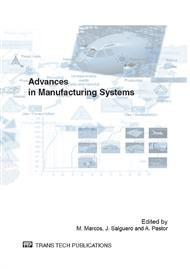[1]
M. Hammer and J. Champy: Reengineering the Corporation: A Manifiesto for Bussiness Revolution (Harper Collins Publishers, 1997).
Google Scholar
[2]
M. M. Andreasen, S. Kähler and T. Lund: Design for Assembly (IFS Publications, UK 1998).
Google Scholar
[3]
G. Boothroyd: Product design for Manufacture and Assembly (Marcel Dekker, USA 1994).
Google Scholar
[4]
J.D. Blackburn: Time Based Competition: The Next battleground in American Manufacturing, (Homewood IL: Business One Irwin, 1991).
Google Scholar
[5]
B.D. Barnett and K.B. Clark: Int. J. of Tech. Manag. Vol. 15 (8) (1998), pp.805-820.
Google Scholar
[6]
J. Pavón and A. Hidalgo: Gestión e Innovación: Un Enfoque Estratégico (Ed. Piramides, Madrid 1997).
Google Scholar
[7]
H. Takeuchi and I. Nonaka: The New New Product Development Game (Harvard Business Review, 1986).
Google Scholar
[8]
C.A. Estorilio: El trabajo de ingenieros en situaciones de desarrollo de productos: Un trabajo de procesos basado en ergonomía (PhD Thesis, Escuela Politécnica Universidad de Sao Paulo 2003).
DOI: 10.2307/j.ctvkwnq83.9
Google Scholar
[9]
UNE 66920-1: Sistemas de Gestión de Diseño, (2000).
Google Scholar
[10]
W.J. Abernathy and J.M. Utterback: Int. J. of Manag. Sci. Vol 3 (6) (1974).
Google Scholar
[11]
Information on http: /www. lulu. com. J. Palacio: Adaptando los Procesos a la Empresa: Flexibilidad con Scrum, (2007).
Google Scholar
[12]
M.W. Pereira and A. L. Manke, in: Metodología de Desarrollo de Productos Aplicando Ingeniería Simultanea, 3º Congreso de Ingeniería Simultánea, Anais, (2001).
Google Scholar
[13]
Y. Akao, in: Deploying Application Manual of Quality Function: Integration of Customer Needs in Product Design, Japan Standard Association, (1988).
Google Scholar
[14]
P. Palady, in: FMEA: Failure Mode and Effect Analysis, Sao Paulo, Iman, (2002).
Google Scholar
[15]
K. Yang and B. El-Haik: Desig for Six Sigma: A Roadmap for Product Development, London, McGraw-Hill, (2003).
Google Scholar
[16]
G.M. Horine: Absolute Beginner´s Guide to Project Management (Ed. Anaya, 2010).
Google Scholar
[17]
Project Management Guide Body of Knowledge, PMBOK 4º Edition.
Google Scholar
[18]
I. Masaaki: Kaizen: The Key to Japan`s Competitive Success (Randon House by Kaizen Institute Ltd., 1995).
Google Scholar
[19]
J.P. Womack, D.T. Jones and D. Roos: The Machine That Changed the World: the Story of Lean Production (Harper Collins Publishers, NY 1991).
Google Scholar
[20]
K. Schwaber: Agile Project Management with Scrum (Microsoft Press, Washington 2004).
Google Scholar


